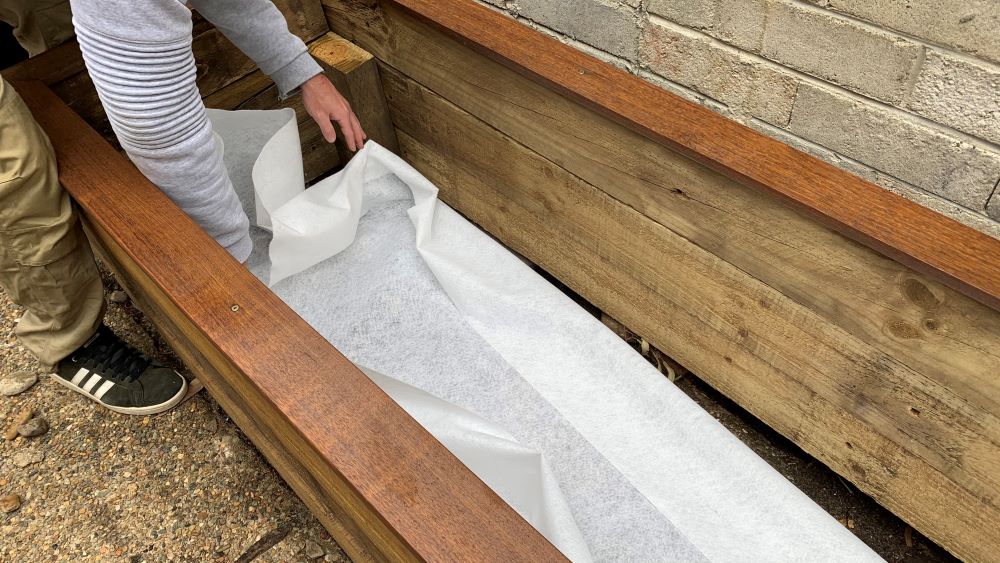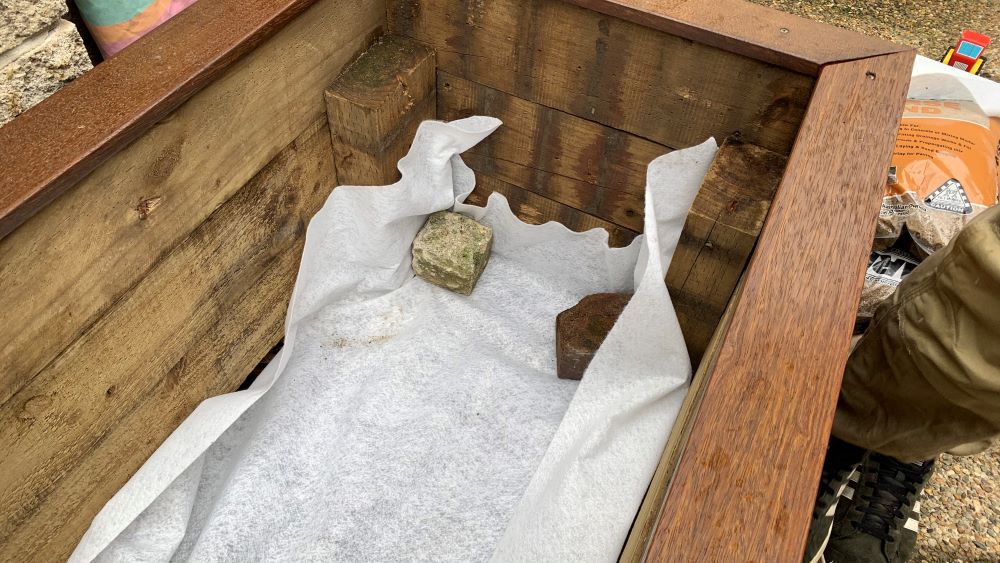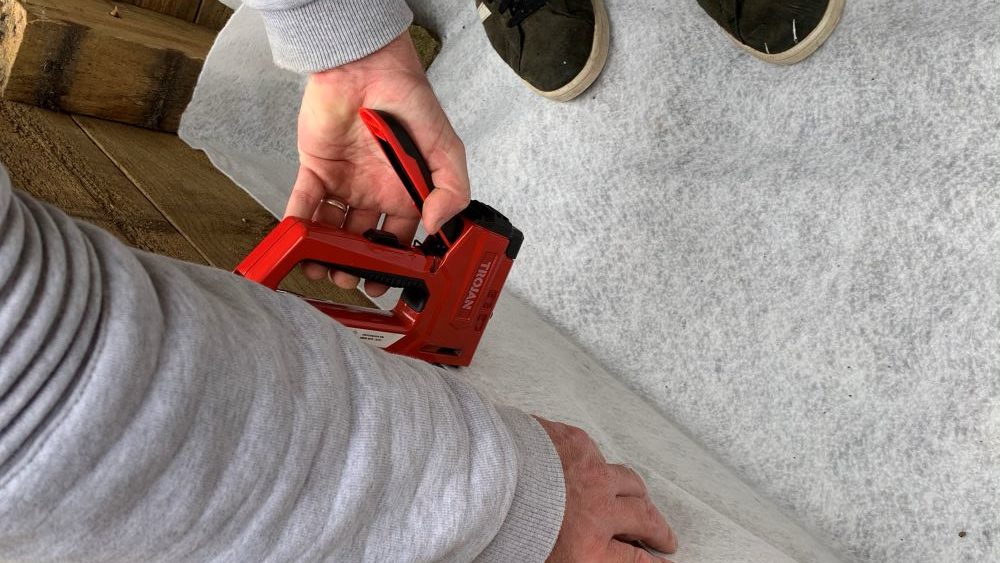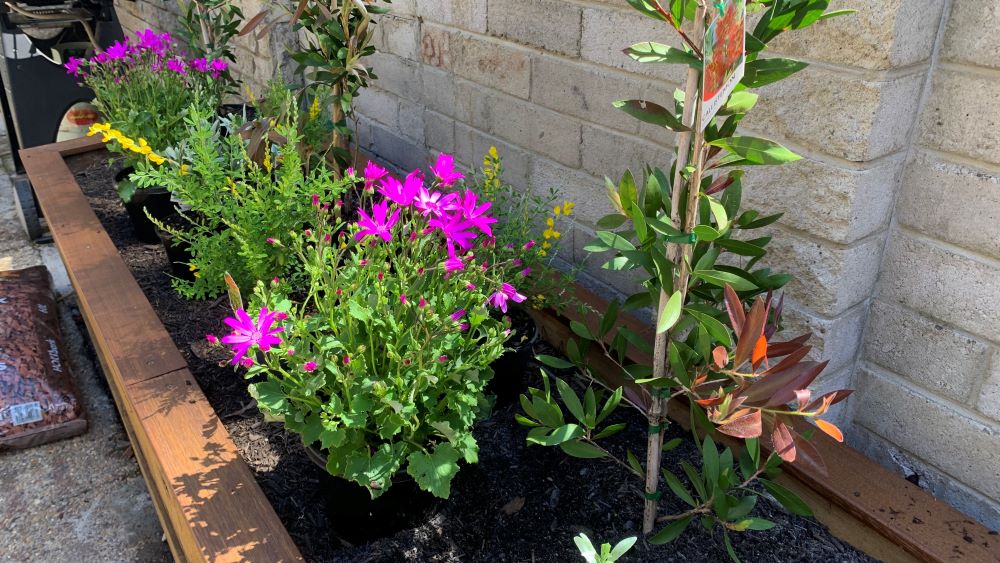Landscape fabric is fantastic for lining raised garden beds as it will help to hold the soil in, protect concrete underneath, it can form a barrier between the vegetables and timber and can hold water in the raised garden bed for longer.
This article will explore the benefits of using landscape fabric to line a new raised garden bed and will show you the best way to hold it in place.

Why you should use landscape fabric to line raised beds
Landscaping fabric makes the perfect lining for a new garden bed for flowers or vegetables. Here are the top benefits of using landscaping fabric.
Landscape fabric holds soil in your raised garden bed
For raised garden beds that do not have a bottom landscaping fabric is a fantastic way to hold soil in. We recently made a new raised garden bed from large timber but it didn’t have a bottom. To hold the new soil in we laid new landscape fabric in the bottom and held it in place with staples.
We built our raised garden bed on concrete so we needed something to hold the soil in. We didn’t want the soil flowing out everywhere. This has done the job and now the garden bed is full of soil and it is held in your garden bed.

Landscaping fabric separates the timber from vegetables
Geofabric or landscaping fabric is a great way to form a barrier between vegetables or fruit grown in a raised garden bed. When building a new garden bed it is best to use untreated or naturally treated timber.
Landscaping fabric can however form a barrier between the timber and anything that can leach out from the timber. This is not so important if you are growing flowers and shrubs in your raised bed but it is always a good idea to add a barrier for vegetables.
Always use natural, untreated timber or make sure it is treated with a safe substance. We have used H4 treated timber for our raised garden bed for flowers and our vegetable beds are made from untreated hardwood with steel sides.
Both of these beds have landscaping fabric lining them but for the vegetable garden, the landscaping fabric goes all the way up to the top of the bed.

Landscaping fabric holds water in longer
Landscaping fabric can be a great way to hold water in the raised garden bed for longer. The landscaping fabric we used can actually works to hold water. It is permeable so water will flow through but it will slowly work its way out rather than rush out of the bottom without the fabric.
Landscaping fabric prevents the loss of nutrients
Landscaping fabric will help to stop soil loss of soil, water and the loss of nutrients. The fabric will hold the soil in and slow the loss of water soluble nutrients from flowing out the bottom.
While landscaping fabric will not stop the nutrients from washing away completely but by holding the soil and water in for longer the nutrients will stay for longer too.

How to hold landscape fabric in place in a raised bed
Hold landscape fabric on the bottom of your raised garden bed with staples. A stapler is a cheap purchase, usually less than $20 and it will make it so easy to hold the fabric in place.
Simply cut the landscaping fabric to size, lay it in the bottom of the garden bed and use your stapler to hold the edges up. You can then lay bricks or rocks in the bottom of the garden bed to fill the bottom.
Then cover the rocks with coarse sand which will fill the gaps between the rocks and bricks and help to hold the water in. Landscaping or coarse river sand will also help to hold water in the garden bed and stop the soil from flowing out the bottom.

Does landscaping fabric go right on the bottom of a raised garden bed?
Landscaping fabric should be placed on the bottom of the garden bed before anything else is placed in the garden bed. The next layers can be bricks, rocks or natural timbers. Then layer coarse sand and on top you can place raised garden bed soil.
Is landscape fabric safe for vegetable gardens?
Landscaping fabric is safe for vegetable gardens. It works well to hold in water, soil and will form a barrier between the vegetables and the timber. This can separate anything that might leach out of the timber including oils.
We have used a natural oil on the outside of our timber garden bed to protect it from the sun. This will not reach the plants and will not cause any harm to their roots.
Where to get landscape fabric
Landscape fabric is available from garden centers, hardware stores or Amazon. Our roll of landscape fabric cost around $40 and is more than we will ever need. It is a small investment for something that you probably won’t need to buy again.
You can also use landscape fabric in the bottom of pots to stop soil from flowing out. This can cover the drainage holes and protect your concrete or pavers for outdoor pots.

Using landscape fabric in raised garden beds | Summary
Landscape fabric is fantastic for lining raised garden beds to hold in soil, nutrients and even hold water in for longer. New garden beds will benefit from landscaping fabric and it will usually be a once off purchase that will give you more than you need for all your garden beds and pots.
Landscaping fabric is a fantastic investment and a great lining for raised garden beds for vegetables, flowers or shrubs.
Happy growing.
I am an accredited practicing dietitian, experienced gardener and a dedicated cook. I love writing and sharing my experience so you can learn from my successes and mistakes.
